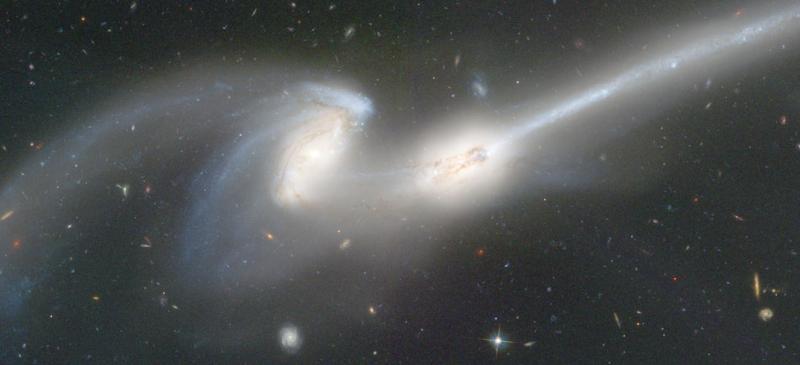Credit & Copyright: ACS Science & Engineering Team,
NASA
Explanation:
These two galaxies are pulling each other apart.
Known as "The Mice" because they have such long tails, each
spiral galaxy
has likely already passed through the other and
will probably collide again and again until they coalesce.
The long tails are created by the relative
difference between gravitational pulls
on the near and far parts of each galaxy.
Scrolling right will show the very long tail of one of the galaxies.
Because the distances are so large,
the whole thing takes place in slow motion --
over hundreds of millions of years.
NGC 4676 lies about 300 million
light-years away toward the constellation of
Coma Berenices and are
likely members of the
Coma Cluster of Galaxies.
The above picture was taken with the
Hubble Space Telescope's new
Advanced Camera for Surveys
which is more sensitive and images a larger field than
previous Hubble cameras.
The camera's increased sensitivity has imaged, serendipitously,
galaxies far
in the distance scattered about the frame.
1999 2000 2001 2002 2003 2004 2005 2006 2007 2008 2009 2010 2011 2012 2013 2014 2015 2016 2017 2018 2019 2020 2021 2022 2023 2024 2025 |
Yanvar' Fevral' Mart Aprel' Mai Iyun' Iyul' Avgust Sentyabr' Oktyabr' Noyabr' Dekabr' |
NASA Web Site Statements, Warnings, and Disclaimers
NASA Official: Jay Norris. Specific rights apply.
A service of: LHEA at NASA / GSFC
& Michigan Tech. U.
|
Publikacii s klyuchevymi slovami:
NGC 4676 - colliding galaxies - stalkivayushiesya galaktiki
Publikacii so slovami: NGC 4676 - colliding galaxies - stalkivayushiesya galaktiki | |
Sm. takzhe:
Vse publikacii na tu zhe temu >> | |
